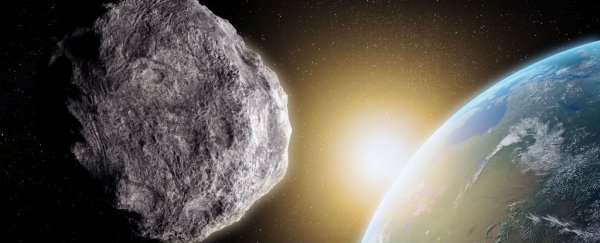It's time to get to know a new friend: asteroid 2015 TB145, a sizeable chunk of rock that's hurtling through space at speeds of over 126,000 km/h (78,293 mph) right now. Discovered just 10 days ago, the asteroid has caught the attention of scientists at NASA because on October 31, it's expected to draw closer to Earth than anything this size has since July 2006.
But before you reach for the keys to your apocalypse bunker, relax. When we say "close", we're talking relatively, which in this case means 1.3 lunar distances, or about 499,000 km (310,000 miles) from Earth.
"This is the closest approach by a known object this large until 1999 AN10 approaches within 1 lunar distance in August 2027," a NASA report states. "The last approach closer than this … was by 2004 XP14 in July 2006 at 1.1 lunar distances."
Detected on October 10 by the Pan-STARRS I survey in Hawaii, which employs several astronomical cameras and telescopes from around the world to identify potentially threatening near-Earth objects, asteroid 2015 TB145 is estimated to be between 280 to 620 metres (918 to 2,034 ft) in diameter.
We've had closer encounters recently, but not by something on this scale. In 2013, Russian motorists filmed a 17-metre meteorite burn up in Earth's atmosphere at a top speed of 19 km/s, and back in 1908, a 40-metre meteorite crashed into a Russian forest.
NASA says asteroid 2015 TB145 has an extremely eccentric and high-inclination orbit, which Colin Jeffrey at Gizmag suggests could be the reason it was only just recently discovered (which is admittedly a bit disconcerting). He adds that while it won't be visible to the naked eye during its closest moments on Halloween, it should be observable to those lucky enough to have a good-quality amateur telescope.
For those playing at home, it's expected to pass through the constellation of Orion at about 17:18 UT on Saturday 31 October. That's 5:18pm EDT and 3:18am AEST.
According to NASA's Near-Earth Object Observations Program, as of 16 October 2015, 13,251 near-Earth objects have been discovered, 877 of which are asteroids with a diameter of approximately 1 kilometre or larger. Some 1,635 of these have been classified as Potentially Hazardous Asteroids (PHAs).
If all that makes you slightly nervous, don't worry. NASA says none of the asteroids or comets it's identified will come close enough to impact Earth anytime in the foreseeable future. "All known Potentially Hazardous Asteroids have less than a 0.01 percent chance of impacting Earth in the next 100 years," they reported back in August. Sure, they didn't spot 2015 TB145 till less than two weeks ago, so what can you do about it?
Lots, as it turns out. You can get involved in the search for near-Earth objects by downloading NASA's free app, called Asteroid Data Hunter. All you need to start helping out is an Internet connection and a telescope. Or you could just sit back and freak yourself out by watching the video below, which visualises space if all the near-Earth Objects we know about were visible. I know which option I'm taking…

